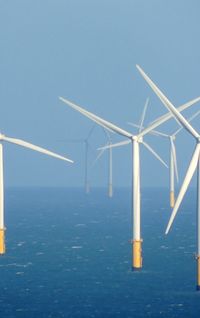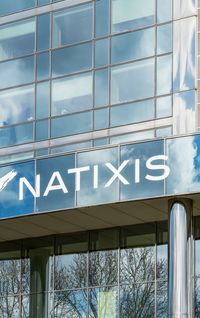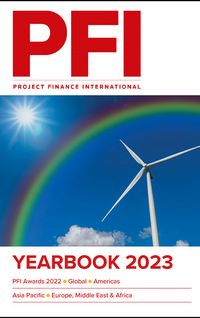Foresight has grown from a specialist private equity and venture capital business into a broad-scope alternative asset manager with more than £12bn of assets under management (AUM) and a sustainability-led focus. But while it may have expanded its investment mandate into the infrastructure sector – the practice now represents around 80% of the business – its essential ethos hasn’t changed. By Nick Herbert.
“It very much informs thinking and the style of approach for a lot of us. How we assess any new opportunity for infrastructure investors and how we grow our business is rooted in how we see the world changing,” said Foresight partner, Dan Wells. “We establish our new investment programmes in the context of long-term trends. The big changes shaping society and planet.”
It’s a strategy that was developed by Foresights two founders – Bernard Fairman and Peter English – who had previously worked in 3i in the UK, where they mainly invested in technology-driven private equity and venture capital structures.
It was during the 2000s that Fairman became aware of the emergence of solar power as a potentially disruptive technology in the energy space. And because of the cost dynamics associated with a new technology, applying Moore's law on improvements in technology to solar suggested significant reductions in cost over time.
That assumption heralded a focus on solar and bioenergy sectors during the 2000s and 2010s and was the catalyst for the firm’s infrastructure programme. Today, its infrastructure practice encompasses other forms of sustainability-led real assets, such as forestry.
Foresight offers a range of products to a diverse base of investors through an array of funds that suit a variety of needs. It has 16 offices across two continents and targets returns from hard-to-access private markets for more than 200 institutional and about 40,000 private investors over three core investment divisions: Sustainable Infrastructure, Private Equity, and Foresight Capital Management.
The Infrastructure practice represents the lion’s share of the firm’s business, the AUM and employee numbers. It manages 399 infrastructure assets across 16 asset classes. “More than 80% of AUM are in our infrastructure practice,” said Wells. “Of the over 300 employees in the firm, about 160 of those are in the infrastructure practice.”
The infrastructure team follows sustainability-led investment strategies across all forms of renewable energy and waste projects, as well as batteries, reserve power and interconnectors in Europe, Australia and North America. The team comprises technical, commercial, development and sustainability specialists. They focus on fundraising, deal origination, execution, and ongoing asset management, and technical support for a wide range of projects across a wide variety of infrastructure sectors.
It has a physical presence in Europe – London, Madrid and Rome, which are its core infrastructure and real assets offices – and Australia. Investment activities of funds with a mandate to invest in North America are covered from Europe.
Head office in Australia is in Sydney, where the team has increased in size following the acquisition of Infrastructure Capital Group (ICG) for an upfront consideration of A$105m in cash and the issue of Foresight shares.
ICG had three flagship funds – the Australian Renewables Income Fund, the Diversified Infrastructure Trust, and the Energy Infrastructure Trust – bringing an additional £3bn-equivalent of assets under management to Foresight at the acquisition close in September. ICG’s management remains in place, and it will operate on a largely standalone basis under chief executive Tom Laidlaw. Foresight’s existing team of seven people in Australia is integrated into ICG.
More than pure renewables
Foresight has several funds investing across different strategies, but all are anchored in the theme of the global "sustainability transition". “We tend to talk about the sustainability transition taking place in three phases,” said Wells.
The first phase is characterised by wind and solar going from a new technology to becoming the backbone of the clean energy system. The second marks the systemic energy transition as networks and systems are fundamentally overhauled and where investment opportunities are as much about enabling infrastructure as they are in renewables themselves. “Several of our funds invest more broadly than purely renewables – areas such as energy storage, grid assets or hydrogen,” said Matt Hammond, partner.
The third phase looks forward to the sustainability transition moving beyond energy into other areas needing to be decarbonised, such as industrial decarbonisation, transport, and food, land and agriculture. “It's in that context that we're looking beyond energy transition to invest in natural capital assets – so forestry, food, soil, oceans,” said Hammond.
It is one axis on which Foresight plots its fund strategy. The other axis represents the types of funds it manages. It has three main pools of capital: listed; private institutional funds; and retail. “We have a range of open-ended funds and closed-ended funds,” said Wells. “All of our funds achieve different outcomes for different investors.”
It has several listed funds, essentially perpetual capital vehicles, including the Foresight Solar Fund that invests in a portfolio of ground-based solar photovoltaics (PV) and battery storage assets in the UK and internationally.
Foresight Energy Infrastructure Partners (FEIP), which secured total commitments of €851.4m from 36 institutional limited partners – all but one based in Europe – in September 2021, some 70% over the €500m original target, is an example of its private institutional funds. “FEIP has a slightly different objective in comparison to our unlisted funds,” said Wells. “It is focused on capital growth as well as yield, as opposed to just yield.”
“The three funds that we've recently started managing in Australia are all open-ended vehicles with yield and capital growth strategies in similar areas to Foresight’s coverage in Europe,” he said.
The third pool of capital it manages is retail, where the objective is capital preservation and paying a return in addition to offering tax-advantaged investments.
Green landscape
“The investment landscape is as interesting now as ever has been as a mid-market, real asset investor,” said Hammond. “Particularly in Europe.”
The advent of the sustainability challenge is driving the need for novel solutions: “And that often requires a lot of capital,” he said. “It's generating a lot more investment opportunities in a mid-market size, and that suits us very well.”
Optimising the potential from investing in an increased range of sustainable asset classes, each with their own risk profiles and investment challenges, is enabled by Foresight’s array of funds under management. Diverse funding channels also help in the provision of investment products to match investor aspirations.
“What is important is having a team big enough and with the right skills to look at new asset classes as they develop,” said Wells. “As well as finance specialists, we've also got engineers and those with other relevant skillsets. Having a team that can deal with all the challenges of a project and look at new opportunities is a useful resource.”
New horizons
The advent of new infrastructure asset classes does not preclude investing in projects that have become part of the mainstream – standalone wind and solar farms, for example. Earlier in 2022, FEIP raised a significant debt package from sole MLA NordLB backing the purchase of its 277MW Kolvallen wind project in Sweden from project developer Arise.
“It’s an example of a pure-play renewables asset and one of our largest investments of any kind to-date,” said Hammond. “But we tend to look at an investment opportunity from the viewpoint of the system as a whole so as to better address the energy trilemma – a core of renewables that generates power, but then having extra components; flexibility in the form of energy storage; and connectivity in the form of grid assets.”
In May, FEIP became the majority shareholder in the 750MW MaresConnect electricity interconnector project linking the power markets of Ireland and Great Britain being developed by Etchea Energy, which holds the remainder of the shares.
The cable route is approximately 245km in length and will run underground and under the sea between Dublin and Bodelwyddan in Wales. The project is expected to take wind power from the Irish grid and reduce the need for curtailment of power from the schemes when the Atlantic winds are at their strongest.
The developers will place the project into the Ofgem bidding round for interconnector schemes to the UK due in June 2023. Ofgem will offer developers from around Europe the chance to secure a cap-and-floor contract, limiting the revenue downside of a project, to back the finances of their projects. The MaresConnect developers will seek a project financing for the scheme and hope to start construction in 2024 and complete in 2027.
As well as connectivity, Foresight is also investing in storage. FEIP has bought 100% of the Glenmuckloch pumped storage hydro (PSH) and wind farm project owned by Buccleuch Estate. The £250m scheme will have a capacity of 210MW of eight-hour storage and 33.6MW of wind.
Connectivity and flexibility enable the provision of deeply decarbonised reliable networks that can produce affordable energy. “The more storage you have, the more flexibility you have, and the more connectivity you have, the lower the cost of decarbonisation,” said Wells.
It doesn't necessarily mean that the optimal strategy is to develop batteries with the renewables assets themselves, as batteries can be built standalone. Equally there are benefits in co-locating batteries with renewable energy assets because they share grid costs.
“We do see more co-located assets, but equally we can still finance assets on a standalone basis,” he said. “We will absolutely invest in wind farms and solar farms that are standalone.”
Early foresight
Wind and solar have become a highly mature, highly established sub-sector for institutional investors. Strong demand for assets in a sub-sector with an established track record and a limited supply of assets elevates competition and prices, and compresses returns.
Foresight’s record in the infrastructure space gives its team a competitive advantage, according to Hammond.
“We don't necessarily fight too hard for very low-risk, low-return assets,” he said. “We have a big team with a lot of experience – we’ve made over 420 investments – and the skills to take on more complex projects. It gives us a high degree of credibility, and transaction execution certainty for bidders and development partners.
“If we are bidding from a vendor that we've previously done deals with, they know we will execute. We are quite disciplined on price, but they know that we will deliver.”
With some of its funds having the ability and appetite to invest at an early stage, Foresight sees that feature as being another way to address the competitiveness of capital. It can’t claim its early-stage investing approach as unique but “we are investing early in funding development or undertaking development ourselves in a broad range of energy investments – solar, wind, batteries, and now an interconnector and pumped hydro”, said Hammond. “We are also developing reserve power assets and geothermal assets, and broadening our purview to other sustainable infrastructure areas.”
Wider footprint
Foresight’s footprint has expanded from its UK base in the last few years to become increasingly focused on the rest of Europe, where it aims to grow its activity – most of its existing funds have a European investment mandate. And the opportunity to acquire ICG in Australia, where it had already established a presence, represented a chance to bolster its activity in a market where there is “a lot of work to be done on sustainable investing, particularly in the energy sector, even before we get to anything else”, said Wells.
While it plans to seek more opportunities in following the energy transition further around the world, it is also adding new investment themes to its stable of funds, such as digital, agriculture, natural capital, and hydrogen.
“These themes are global, and all of the expertise and experience we've been accumulating in energy transition and sustainable infrastructure investing is applicable everywhere,” said Hammond.
The importance of renewable energy in ensuring long-term energy security, realising decarbonisation and providing the most affordable forms of power has only been exacerbated by events of the past year. Legislation and regulation in Europe and the US are incentivising renewable energy generation and enabling technology. They represent clear tailwinds for energy transition investment themes.
“Whilst we're investing in areas such as energy storage, interconnectors, and hydrogen fuel, there's so much for us to do in green energy and that's where the growth is,” said Wells. “The investment opportunity for wind and solar is big and it will continue to grow. The limiting factor is just how much can be built out each year.”
To see the digital version of this report, please click here
To purchase printed copies or a PDF of this report, please email leonie.welss@lseg.com
![]()

















